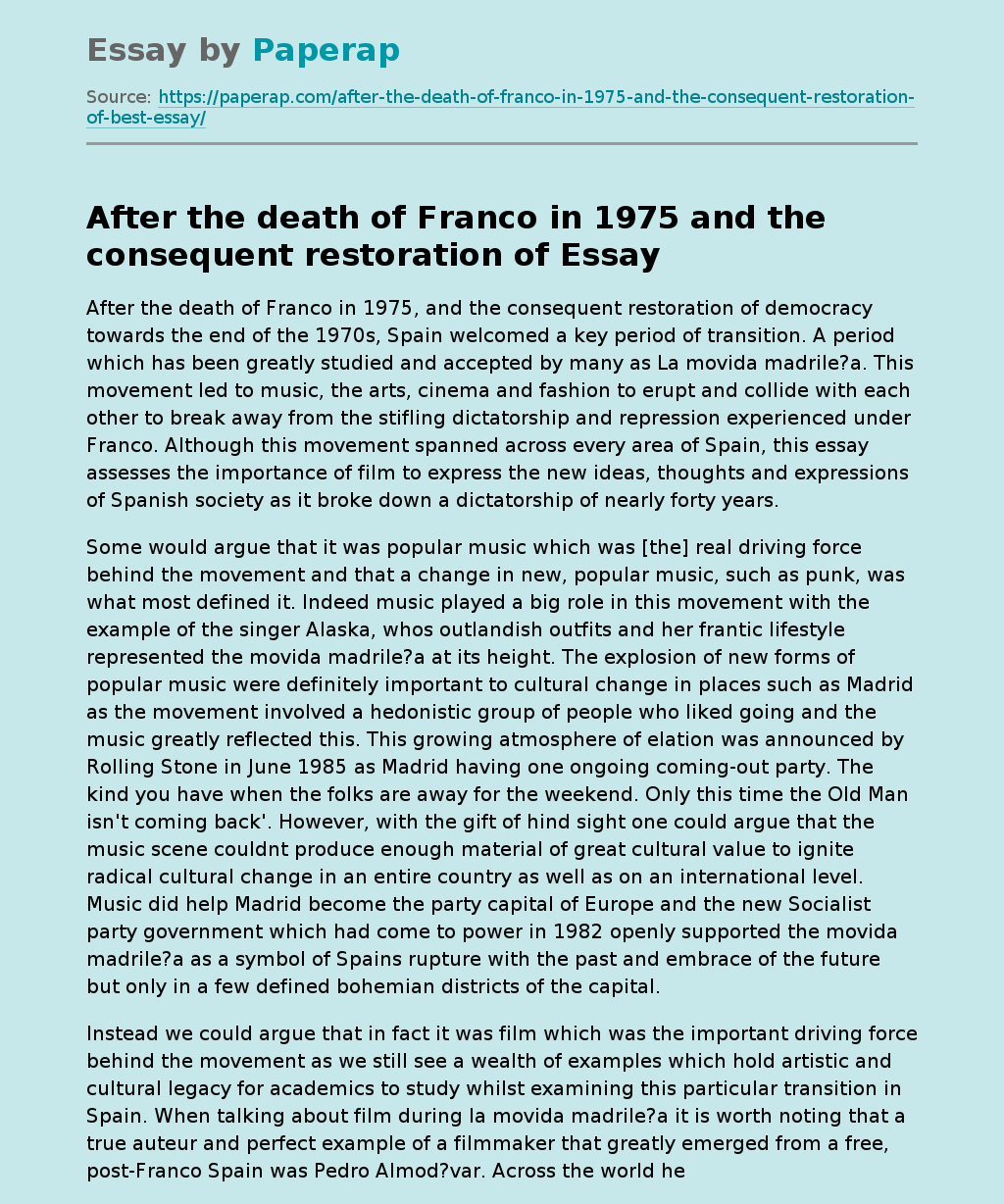After the death of Franco in 1975, and the consequent restoration of democracy towards the end of the 1970s, Spain welcomed a key period of transition. A period which has been greatly studied and accepted by many as La movida madrilea. This movement led to music, the arts, cinema and fashion to erupt and collide with each other to break away from the stifling dictatorship and repression experienced under Franco. Although this movement spanned across every area of Spain, this essay assesses the importance of film to express the new ideas, thoughts and expressions of Spanish society as it broke down a dictatorship of nearly forty years.
Some would argue that it was popular music which was [the] real driving force behind the movement and that a change in new, popular music, such as punk, was what most defined it. Indeed music played a big role in this movement with the example of the singer Alaska, whos outlandish outfits and her frantic lifestyle represented the movida madrilea at its height.
The explosion of new forms of popular music were definitely important to cultural change in places such as Madrid as the movement involved a hedonistic group of people who liked going and the music greatly reflected this. This growing atmosphere of elation was announced by Rolling Stone in June 1985 as Madrid having one ongoing coming-out party. The kind you have when the folks are away for the weekend. Only this time the Old Man isn’t coming back’. However, with the gift of hind sight one could argue that the music scene couldnt produce enough material of great cultural value to ignite radical cultural change in an entire country as well as on an international level.
Music did help Madrid become the party capital of Europe and the new Socialist party government which had come to power in 1982 openly supported the movida madrilea as a symbol of Spains rupture with the past and embrace of the future but only in a few defined bohemian districts of the capital.
Instead we could argue that in fact it was film which was the important driving force behind the movement as we still see a wealth of examples which hold artistic and cultural legacy for academics to study whilst examining this particular transition in Spain. When talking about film during la movida madrile?a it is worth noting that a true auteur and perfect example of a filmmaker that greatly emerged from a free, post-Franco Spain was Pedro Almodvar. Across the world he has received major international acclaim for his outstanding work in the film industry, however, it could be argued that Almodvars use of film as a tool for change after Francos death was the main driving force behind this movement. Whilst casting himself and certain actors such as Carmen Maura and Mara Olvido Gara Jova, better known as Alaska, into the international spotlight, he helped propel Spanish culture and society back into international acclaim through the use of his lens. The distribution of some of his first films such as Pepi, Luci, Bom y otras chicas del mont?n, Laberinto de Pasiones, and especially ?Qu he hecho yo para merecer esto?, help to cement the idea of this scene as the major cultural movement in 1980s Spain and by extension, its position as the primary source and representative of radical socio-cultural change in post-Francoist Spain.
Films can be seen as perhaps the most important device of la movida madrilea as they had not only a national outreach, amongst almost all urban areas in Spain itself, but also an international reach. Ironically it was the repression and strict rule under Francos regime that seemed to instigate the basis of the insurgent counterculture which flourished after his death as no more censorship meant such films could be distributed abroad as well. Although subtle changes to try and undermine the notion of the traditional society in Spain had been happening under the surface for a while, it wasnt until 1985 that the censorship of most artistic platforms was abolished by the newly democratic government. The break-down of censorship laws allowed films to be the at the forefront of this movement as themes such as corruption within the traditional family, the government, and the Catholic church, concepts which were expertly concealed during the dictatorship, sprung out.
Pepi, Luci, Bom y otras chicas del montn, for example, captures brilliantly the spirit of la movida. It is openly both sexually and culturally liberal and gained many cult followers, propelling both Almodovars unstoppable career and the change in themes amongst films of the time. It was through Almodvars ground-breaking films that we began to see a more truthful focus on the problems wracking Spanish society and especially that of Madrid. This film in particular was a parody about patriarchy, machismo, traditional marriage, lesbian- ism, and sadomasochistic relationships. This 1980 movie is a send-up of everything and anything thats related to sexuality Almodvar therefore, didnt hesitate to focus on formerly taboo subjects like corrupt policemen, homosexuality, drug use, gender issues, HIV, prostitution, sex, and abuse. These films were so important in shaping the attitudes of the new Spanish society as they reflected the freedom of the moment as Spaniards rushed to catch up with the lifestyle enjoyed by other countries in the west.
It is fair to say that Madrid has been transformed into a cultural oasis…A city reborn to run with the success of La movida madrile?a still visible in Spanish society amongst Madrids art, theatre and music. However, particularly so in Almod?vars films. These films will transcend longer than the music of the movement as their genre wont change or become outdated but instead the films will remain as examples of material which paved the way for a new generation of creativity and liberty, and which worked to shape Spain into the freer society we know and love today.
Carmen Maura and Mara Olvido Gara Jova. (2019, Dec 05). Retrieved from https://paperap.com/after-the-death-of-franco-in-1975-and-the-consequent-restoration-of-best-essay/

